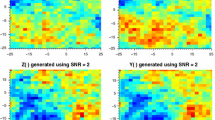Abstract
In this article we develop a new method to grid passive microwave data in the presence of spatial correlation patterns. Our proposal combines a Tychonov inverse method with a generalized cross validation procedure to grid the observations over a discrete retrieval grid. To build this grid, the study region is partitioned into objects following an object-based image analysis procedure. Then, this partition is refined into small cells of similar size. Two cells from the same object are considered of the same type. The procedure to estimate the brightness temperature of each cell is based on a least-squares estimation with a cell-type aware Tychonov regularization method. This method assumes that the brightness temperature heterogeneity within each cell can be neglected and that adjacent cells of the same type have similar brightness temperature. In other words, spatial correlations are considered within each object in the scene. The Tychonov regularization parameter is found using a fast generalized cross validation procedure that makes it possible to solve the inverse problem when the observational error variance is not known. We evaluate the proposed method using different synthetic scenarios and compare it with other methods. The evaluation shows an excellent performance of the proposed method when the brightness temperature field varies smoothly over each object in the scene. But it also shows that the method is competitive when the brightness temperature field does not present spatial correlations. We conclude that the proposed algorithm provides a fast and robust method to solve the original inverse problem.




Similar content being viewed by others
References
Aster R, Borchers B, Thurber C (2005) Parameter estimation and inverse problems. Elsevier Academic, New York
Bellerby T, Taberner M, Wilmshurst A, Beaumont M, Barrett E, Scott J, Durbin C (1998) Retrieval of land and sea brightness temperatures from mixed coastal pixels in passive microwave data. IEEE Trans Geosci Remote Sens 36(6):1844–1851
Choudhury BJ (1989) Monitoring global land surface using Nimbus-7 37 GHz data theory and examples. Int J Remote Sens 10(10):1579–1605
Grimson R, Bali JL, Rajngewerc M, Martín LS, Salvia M (2019) A statistical inverse method for gridding passive microwave data with mixed measurements. IEEE Trans Geosci Remote Sens 57 (3):1347–1357
JAXA (2013) Descriptions of GCOM-W1 AMSR2 level 1R and level 2 algorithms. Tech. rep. Japan Aerospace Exploration Agency, Earth Observation Research Center
Jones LA, Kimball JS, McDonald KC, Chan STK, Njoku EG, Oechel WC (2007) Satellite microwave remote sensing of boreal and arctic soil temperatures from AMSR-E. IEEE Trans Geosci Remote Sens 45(7):2004–2018
Limaye AS, Crosson WL, Laymon CA, Njoku EG (2004) Land cover-based optimal deconvolution of PALS L-band microwave brightness temperatures. Remote Sens Environ 92(4):497–506
Min Q, Lin B, Li R (2010) Remote sensing vegetation hydrological states using passive microwave measurements. IEEE J Sel Top Appl Earth Obs Remote Sens 3(1):124–131
Njoku EG, Jackson TJ, Lakshmi V, Chan TK, Nghiem SV (2003) Soil moisture retrieval from AMSR-E. IEEE Trans Geosci Remote Sens 41(2):215–229
Poe GA (1990) Optimum interpolation of imaging microwave radiometer data. IEEE Trans Geosci Remote Sens 28(5):800–810
Rees WG (2013) Physical principles of remote sensing. Cambridge University Press, New York
Rodgers CD (2000) Inverse methods for atmospheric sounding: theory and practice, vol 2. World Scientific, Singapore
Sippel SJ, Hamilton SK, Melack JM, Choudhury BJ (1994) Determination of inundation area in the Amazon River floodplain using the SMMR 37 ghz polarization difference. Remote Sens Environ 48 (1):70–76
Stogryn A (1978) Estimates of brightness temperatures from scanning radiometer data. IEEE Trans Antennas Propag 26(5):720–726
Twomey S (1977) Introduction to the mathematics of inversion in remote sensing and indirect measurements. Dover, The Netherlands
Ulaby FT, Moore RK, Fung AK (1981) Microwave remote sensing: active and passive, vol I, II and III. Artech House, Norwood, Massachusetts
Zhang L, Zhao T, Jiang L, Zhao S (2010) Estimate of phase transition water content in freeze–thaw process using microwave radiometer. IEEE Trans Geosci Remote Sens 48(12):4248–4255
Author information
Authors and Affiliations
Corresponding author
Additional information
Communicated by: H. Babaie
Publisher’s note
Springer Nature remains neutral with regard to jurisdictional claims in published maps and institutional affiliations.
This research was partially supported by PICT 2016-4089 and 2014-0824 from the ANPCyT, Argentina.
Rights and permissions
About this article
Cite this article
Bali, J.L., Cerdeiro, M., Rajngewerc, M. et al. A new method for gridding passive microwave data with mixed measurements and spatial correlation. Earth Sci Inform 13, 1383–1391 (2020). https://doi.org/10.1007/s12145-020-00513-1
Received:
Accepted:
Published:
Issue Date:
DOI: https://doi.org/10.1007/s12145-020-00513-1




